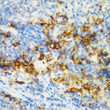| Tissue Specificity | CD3D is mostly present on T-lymphocytes with its TCR-CD3 partners. Present also in fetal NK-cells. |
| Post Translational Modifications | Phosphorylated on Tyr residues after T-cell receptor triggering by LCK in association with CD4/CD8. |
| Function | Part of the TCR-CD3 complex present on T-lymphocyte cell surface that plays an essential role in adaptive immune response. When antigen presenting cells (APCs) activate T-cell receptor (TCR), TCR-mediated signals are transmitted across the cell membrane by the CD3 chains CD3D, CD3E, CD3G and CD3Z. All CD3 chains contain immunoreceptor tyrosine-based activation motifs (ITAMs) in their cytoplasmic domain. Upon TCR engagement, these motifs become phosphorylated by Src family protein tyrosine kinases LCK and FYN, resulting in the activation of downstream signaling pathways. In addition of this role of signal transduction in T-cell activation, CD3D plays an essential role in thymocyte differentiation. Indeed, participates in correct intracellular TCR-CD3 complex assembly and surface expression. In absence of a functional TCR-CD3 complex, thymocytes are unable to differentiate properly. Interacts with CD4 and CD8 and thus serves to establish a functional link between the TCR and coreceptors CD4 and CD8, which is needed for activation and positive selection of CD4 or CD8 T-cells. |
| Protein Name | T-Cell Surface Glycoprotein Cd3 Delta ChainT-Cell Receptor T3 Delta ChainCd Antigen Cd3d |
| Database Links | Reactome: R-HSA-198933Reactome: R-HSA-202424Reactome: R-HSA-202427Reactome: R-HSA-202430Reactome: R-HSA-202433Reactome: R-HSA-389948Reactome: R-HSA-8856825Reactome: R-HSA-8856828 |
| Cellular Localisation | Cell MembraneSingle-Pass Type I Membrane Protein |
| Alternative Antibody Names | Anti-T-Cell Surface Glycoprotein Cd3 Delta Chain antibodyAnti-T-Cell Receptor T3 Delta Chain antibodyAnti-Cd Antigen Cd3d antibodyAnti-CD3D antibodyAnti-T3D antibody |
Information sourced from Uniprot.org











